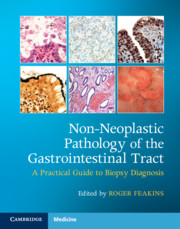Book contents
- Non-Neoplastic Pathology of the Gastrointestinal Tract
- Non-Neoplastic Pathology of the Gastrointestinal Tract
- Copyright page
- Dedication
- Contents
- Preface
- Acknowledgements
- Contributors
- Chapter 1 The Value of Gastrointestinal Biopsy
- Chapter 2 Gastrointestinal Involvement by Systemic Disease
- Chapter 3 Radiation and the Gastrointestinal Tract
- Chapter 4 Transplantation, Immunodeficiency, and Immunosuppression
- Chapter 5 Drug-Induced Gastrointestinal Disease
- Chapter 6 Gastrointestinal Ischemia and Vascular Disorders
- Chapter 7 Paediatric Conditions
- Chapter 8 Gastrointestinal Dysplasia
- Chapter 9 Normal Oesophageal, Gastric and Duodenal Mucosa
- Chapter 10 Histology of Gastroesophageal Reflux Disease and Barrett’s Oesophagus
- Chapter 11 Infections of the Oesophagus and Rare Forms of Oesophagitis
- Chapter 12 Assessment of Gastric Biopsies
- Chapter 13 Types of Gastritis
- Chapter 14 Duodenitis
- Chapter 15 Coeliac Disease
- Chapter 16 Inflammatory Bowel Disease and the Upper Gastrointestinal Tract
- Chapter 17 Normal Lower Gastrointestinal Mucosa
- Chapter 18 Infectious Disorders of the Lower Gastrointestinal Tract
- Chapter 19 Jejunitis and Ileitis
- Chapter 20 Microscopic Colitis
- Chapter 21 Inflammatory Bowel Disease Diagnosis
- Chapter 22 Mimics of Inflammatory Bowel Disease
- Chapter 23 Complications of Inflammatory Bowel Disease
- Chapter 24 Approach to Reporting Inflammatory Bowel Disease Biopsies
- Chapter 25 Ileal Pouch Anal Anastomosis
- Chapter 26 Diverticular Disease, Mucosal Prolapse, and Related Conditions
- Chapter 27 Non-Neoplastic Diseases of the Anal Canal
- Index
- References
Chapter 18 - Infectious Disorders of the Lower Gastrointestinal Tract
Published online by Cambridge University Press: 06 June 2020
- Non-Neoplastic Pathology of the Gastrointestinal Tract
- Non-Neoplastic Pathology of the Gastrointestinal Tract
- Copyright page
- Dedication
- Contents
- Preface
- Acknowledgements
- Contributors
- Chapter 1 The Value of Gastrointestinal Biopsy
- Chapter 2 Gastrointestinal Involvement by Systemic Disease
- Chapter 3 Radiation and the Gastrointestinal Tract
- Chapter 4 Transplantation, Immunodeficiency, and Immunosuppression
- Chapter 5 Drug-Induced Gastrointestinal Disease
- Chapter 6 Gastrointestinal Ischemia and Vascular Disorders
- Chapter 7 Paediatric Conditions
- Chapter 8 Gastrointestinal Dysplasia
- Chapter 9 Normal Oesophageal, Gastric and Duodenal Mucosa
- Chapter 10 Histology of Gastroesophageal Reflux Disease and Barrett’s Oesophagus
- Chapter 11 Infections of the Oesophagus and Rare Forms of Oesophagitis
- Chapter 12 Assessment of Gastric Biopsies
- Chapter 13 Types of Gastritis
- Chapter 14 Duodenitis
- Chapter 15 Coeliac Disease
- Chapter 16 Inflammatory Bowel Disease and the Upper Gastrointestinal Tract
- Chapter 17 Normal Lower Gastrointestinal Mucosa
- Chapter 18 Infectious Disorders of the Lower Gastrointestinal Tract
- Chapter 19 Jejunitis and Ileitis
- Chapter 20 Microscopic Colitis
- Chapter 21 Inflammatory Bowel Disease Diagnosis
- Chapter 22 Mimics of Inflammatory Bowel Disease
- Chapter 23 Complications of Inflammatory Bowel Disease
- Chapter 24 Approach to Reporting Inflammatory Bowel Disease Biopsies
- Chapter 25 Ileal Pouch Anal Anastomosis
- Chapter 26 Diverticular Disease, Mucosal Prolapse, and Related Conditions
- Chapter 27 Non-Neoplastic Diseases of the Anal Canal
- Index
- References
Summary
The lower gastrointestinal tract consists of ileum, vermiform appendix, colon, and rectum. The main epithelial cell types are absorptive cells, goblet cells, Paneth cells, and endocrine cells. Structurally the ileum resembles the duodenum, and includes villi and crypts. Gut-associated lymphoid tissue plays an important role in immune defence and has focal and diffuse elements in the small bowel. Lymphoid tissue is particularly prominent in the most distal part of the ileum. The mucosa of the large bowel is less complex than that of the small bowel, with parallel crypts and a smooth surface. In the normal colorectal mucosa, the density of plasma cells is highest in the upper one third and lowest in the lower one third. Eosinophilia in the ileum and large bowel is difficult to diagnose unless numbers are greatly increased. There may be a few neutrophils in the normal lamina propria but intraepithelial neutrophils are very infrequent. Apoptosis is a normal finding but the number of well-developed crypt epithelial cell apoptosis should be small. The intraepithelial lymphocyte count in the ileum is 0–9 per 100 surface epithelial cells and in the colon 0–5 per 100. Knowledge of the range of normality is important and helps pathologists to avoid overdiagnosis of inflammatory changes and of neoplasia.
- Type
- Chapter
- Information
- Non-Neoplastic Pathology of the Gastrointestinal TractA Practical Guide to Biopsy Diagnosis, pp. 260 - 286Publisher: Cambridge University PressPrint publication year: 2020



